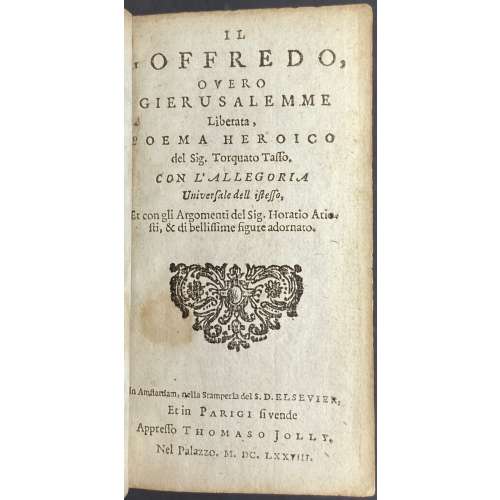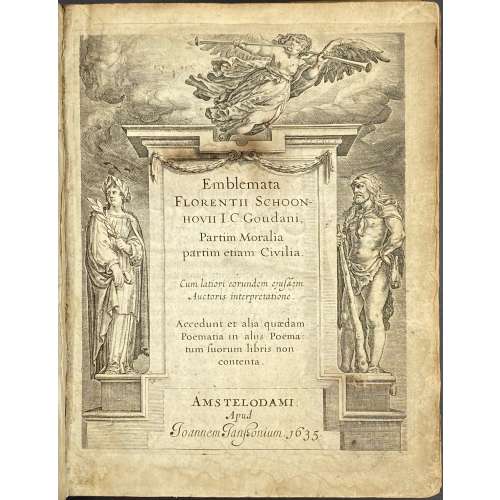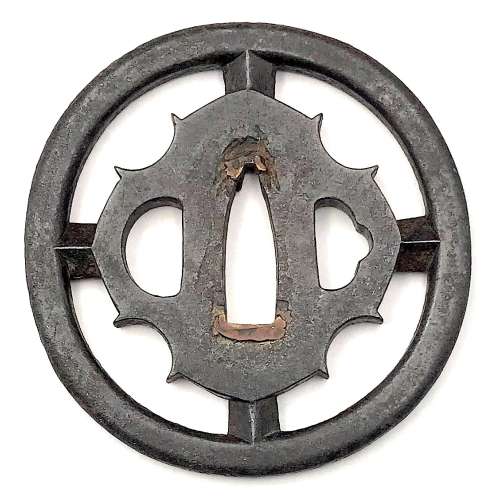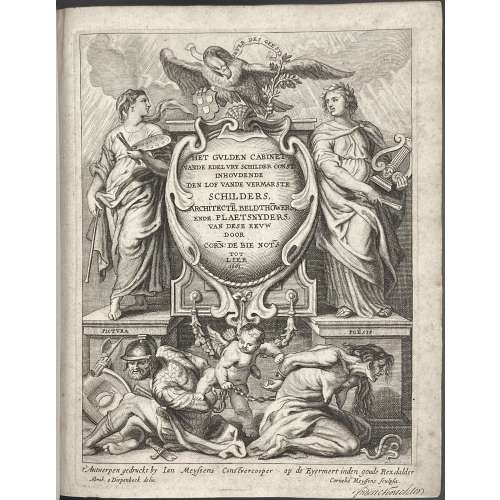-
 Vol. 1: Engraved t.p.: An architectural setting with flags and arms, and sitting male and female figures in armour, perhaps representing Tancredi and Clorinda, with lettering above their heads: “GIERVSA– | LEMME | LIBERATA”. Title-page: IL | GOFFREDO, | OVERO | GIERUSALEMME | Liberata , | POEMA HEROICO | del Sig. Torquato Tasso. | CON L’ ALLEGORIA | Universale dell istesso, | Et con gli Argomenti del Sig. Horatio Ario- | sti, & di belissime figure adornato. | {woodcut element} | In Amsterdam, nella Stamperia del S.D. ELZEVIER, | Et in Parigi, si vende | Appresso Thomaso Jolly. | Nel Palazzo, M. DC. LXXVIII. || Collation: 8vo; [A1] 1st blank, engraved t.p., [A2] letterpress t.p., pp. [1-4]; signatures start at A3, pagination starts at p. 37; Allegoria: A3-B1, pp. [5-18], Tavola: B2-C2, pp. [19-36]; Il Goffredo: C3-R8, pp. 37-271 [272]. Total A-R8: 136 leaves (272 pages), plus 11 plates, incl. engraved t.p., and frontispiece (sculptural bust portrait of Torquato Tasso in a laurel wreath, with a lettered plate below “TORQVATO | TASSO”). Vol. 1: Title-page: Similar but “TOMO II.” after “sti, & di belissime figure adornato.” and before the woodcut element. Collation: 8vo; 1st blank, letterpress t.p., signatures start at A3, p. 5; A-S8, pp. [4] 5-285 [3]. Total A-S8: 144 leaves (288 pages) plus 10 engraved plates. Binding: Two volumes 15 x 6 cm, uniformly bound in 19th-century green morocco, gilt triple-fillet border, bull heads at corners, spine with raised bands, gilt in compartments, two gilt-lettered crimson labels, blue endpapers, 2 blank laid paper leaves in the front, AEG. Contributors: Torquato Tasso (Italian, 1544 –1595) – author. Daniel Elzevir (Dutch, 1626-1680) – publisher. Thomas Jolly (French, fl. 1648 – 1694) – publisher.
Vol. 1: Engraved t.p.: An architectural setting with flags and arms, and sitting male and female figures in armour, perhaps representing Tancredi and Clorinda, with lettering above their heads: “GIERVSA– | LEMME | LIBERATA”. Title-page: IL | GOFFREDO, | OVERO | GIERUSALEMME | Liberata , | POEMA HEROICO | del Sig. Torquato Tasso. | CON L’ ALLEGORIA | Universale dell istesso, | Et con gli Argomenti del Sig. Horatio Ario- | sti, & di belissime figure adornato. | {woodcut element} | In Amsterdam, nella Stamperia del S.D. ELZEVIER, | Et in Parigi, si vende | Appresso Thomaso Jolly. | Nel Palazzo, M. DC. LXXVIII. || Collation: 8vo; [A1] 1st blank, engraved t.p., [A2] letterpress t.p., pp. [1-4]; signatures start at A3, pagination starts at p. 37; Allegoria: A3-B1, pp. [5-18], Tavola: B2-C2, pp. [19-36]; Il Goffredo: C3-R8, pp. 37-271 [272]. Total A-R8: 136 leaves (272 pages), plus 11 plates, incl. engraved t.p., and frontispiece (sculptural bust portrait of Torquato Tasso in a laurel wreath, with a lettered plate below “TORQVATO | TASSO”). Vol. 1: Title-page: Similar but “TOMO II.” after “sti, & di belissime figure adornato.” and before the woodcut element. Collation: 8vo; 1st blank, letterpress t.p., signatures start at A3, p. 5; A-S8, pp. [4] 5-285 [3]. Total A-S8: 144 leaves (288 pages) plus 10 engraved plates. Binding: Two volumes 15 x 6 cm, uniformly bound in 19th-century green morocco, gilt triple-fillet border, bull heads at corners, spine with raised bands, gilt in compartments, two gilt-lettered crimson labels, blue endpapers, 2 blank laid paper leaves in the front, AEG. Contributors: Torquato Tasso (Italian, 1544 –1595) – author. Daniel Elzevir (Dutch, 1626-1680) – publisher. Thomas Jolly (French, fl. 1648 – 1694) – publisher. -
 Mukade-zōgan tsuba with two types of wires. Iron, inlaid with brass and iron wire fastened to the surface with metal staples (mukade-zōgan); Brass inlay around the rim. Design is thought to resemble a centipede. "Centipede-like inlay (mukade zogan) of alternating iron and brass staples produce an appearance that was particularly favored by Takeda Shingen (1521-1573), one of the most powerful warlords of his time. The centipede is sacred to Bishamon (God of War) and especially propitious for a warrior. Shingen type, 16th century.” [The Peabody Museum collection of Japanese sword guards with selected pieces of sword furniture, by John D. Hamilton. Photographs by Mark Sexton. Salem, MA, 1975.] Height: 85.8 mm; Width 86.2 mm; Thickness at seppa-dai: 4.3 mm. Weight 177.6 g. Early Edo, 17th century. http://varshavskycollection.com/shingen-tsuba/
Mukade-zōgan tsuba with two types of wires. Iron, inlaid with brass and iron wire fastened to the surface with metal staples (mukade-zōgan); Brass inlay around the rim. Design is thought to resemble a centipede. "Centipede-like inlay (mukade zogan) of alternating iron and brass staples produce an appearance that was particularly favored by Takeda Shingen (1521-1573), one of the most powerful warlords of his time. The centipede is sacred to Bishamon (God of War) and especially propitious for a warrior. Shingen type, 16th century.” [The Peabody Museum collection of Japanese sword guards with selected pieces of sword furniture, by John D. Hamilton. Photographs by Mark Sexton. Salem, MA, 1975.] Height: 85.8 mm; Width 86.2 mm; Thickness at seppa-dai: 4.3 mm. Weight 177.6 g. Early Edo, 17th century. http://varshavskycollection.com/shingen-tsuba/ -
 Title: Emblemata | Florentii Schoon~ | hovii I. C. Goudani, | Partim moralia | partim etiam Civilia. | Cum latiori eorundem ejusdem | Auctoris interpretatione. | Accedunt et alia quædam | Poëmatia in alijs Poëma | tum suorum libris non | contenta. | Amstelodami. | Apud | Joannem Janßonium •1635• Size: 20 x15.5 cm, small 4to Edition: 3rd edition (the first two editions being by Burier, Gouda, 1618 and by Elzevir, Leiden, 1626. Collation: ¶/*6, A-Z4, Aa-Ff4, Gg2. Pagination: [2] - enrgaved t.p. / blank, [6] - dedication, [2] - lectori benevolo, [2] - in commend. / frontis. engraved portrait of Gerardus Traudenius – academic/intellectual; author/poet (Dutch, fl. 1615 – 1623), 1-235. Illustrated with engraved title, portrait of dedicatee, and 74 engraved emblems by Crispijn van de Passe the Younger (1594/5 – 1670). Binding: bound in full contemporary Dutch blind-stamped parchment over thin boards, laced case construction, inked title to spine, no flyleaves, signature washed from the title, the blank margin of title trimmed away at head, slight marginal water stain to the first signature, front bottom board corner bumped.
Title: Emblemata | Florentii Schoon~ | hovii I. C. Goudani, | Partim moralia | partim etiam Civilia. | Cum latiori eorundem ejusdem | Auctoris interpretatione. | Accedunt et alia quædam | Poëmatia in alijs Poëma | tum suorum libris non | contenta. | Amstelodami. | Apud | Joannem Janßonium •1635• Size: 20 x15.5 cm, small 4to Edition: 3rd edition (the first two editions being by Burier, Gouda, 1618 and by Elzevir, Leiden, 1626. Collation: ¶/*6, A-Z4, Aa-Ff4, Gg2. Pagination: [2] - enrgaved t.p. / blank, [6] - dedication, [2] - lectori benevolo, [2] - in commend. / frontis. engraved portrait of Gerardus Traudenius – academic/intellectual; author/poet (Dutch, fl. 1615 – 1623), 1-235. Illustrated with engraved title, portrait of dedicatee, and 74 engraved emblems by Crispijn van de Passe the Younger (1594/5 – 1670). Binding: bound in full contemporary Dutch blind-stamped parchment over thin boards, laced case construction, inked title to spine, no flyleaves, signature washed from the title, the blank margin of title trimmed away at head, slight marginal water stain to the first signature, front bottom board corner bumped. -
 Iron tsuba of almost round form with a brass outlined circular opening (sukashi) in the bottom adorned with the Myriad Treasures [takaramono, 宝物] and winter motifs inlaid in cast brass (suemon-zōgan); hitsu-ana possibly cut later, both plugged with shakudo, nakaga-ana fitted with copper sekigane. According to Merrily Baird*) (2001), the symbolism of Myriad Treasures “is associated with the Seven Gods of Good Luck, who carry them in a sack”. Among the treasures, which are said to ensure prosperity, long life, and general good fortunes, are (reading clockwise from the top):
Iron tsuba of almost round form with a brass outlined circular opening (sukashi) in the bottom adorned with the Myriad Treasures [takaramono, 宝物] and winter motifs inlaid in cast brass (suemon-zōgan); hitsu-ana possibly cut later, both plugged with shakudo, nakaga-ana fitted with copper sekigane. According to Merrily Baird*) (2001), the symbolism of Myriad Treasures “is associated with the Seven Gods of Good Luck, who carry them in a sack”. Among the treasures, which are said to ensure prosperity, long life, and general good fortunes, are (reading clockwise from the top):- Sake set [shuki, 酒器], namely flask, ladle, and cups
- Cloves [choji, 丁子]
- Purse of inexhaustible reaches [kinchaku, 巾着]
- Magic mallet [kozuchi, 小槌]
- Key to the storehouse of the Gods [kagi, 鍵]
- Rhombus, or Lozenge (hosho, 方勝), with the second ideograph meaning victory.
- Sacred (or wish-granting) gem, or jewel [hōju, 宝珠]
- Hats of invisibility [kakuregasa, 隠れ笠]
-
 Iron tsuba of round form with slanting rays of light (shakoh) Christian motif (Jesuit's IHS symbol) in openwork (sukashi). Traditional description of this kind of design is called "tokei", or "clock gear". Edo period.
Iron tsuba of round form with slanting rays of light (shakoh) Christian motif (Jesuit's IHS symbol) in openwork (sukashi). Traditional description of this kind of design is called "tokei", or "clock gear". Edo period.Size: 77.7 x 76.1 x 6.7 mm.
For information regarding shakoh tsuba see article 'Kirishitan Ikenie Tsuba" by Fred Geyer at Kokusai Tosogu Kai; The 2nd International Convention & Exhibition, October 18-23, 2006, pp. 84-91. -
 Engraved title page:
Engraved title page:- In an oval cartouche at the centre, flanked by female personifications of Painting and Poetry, surmounted by an eagle, Mars and Envy chained by Cupid below: HET GULDEN CABINET | VANDE EDEL VRY SCHILDER, CONST | INHOUDENDE | DEN LOF VANDE VERMARSTE | SCHILDERS, | ARCHITECTE, BELDTHOWERS | ENDE PLAETSNYDERS | VAN DESE EEVW | DOOR | CORN: DE BIE NOTS. | TOT | LIER | 1661. ||
- In lower margin below the image frame: t’Antwerpen gedruckt by Ian Meyssens Constvercooper op de Eyermert inden goude Rexdalder | Abrah. a Diepenbeck delin. — Cornelis Meyssens sculpsit. || Handwritten inscription below: Frederik Verachter
Cornelis de Bie. Het Gulden Cabinet. — Antwerp: [J. van Montfort for] Jan Meyssens, 1661 [colophon: 1662]. First edition, quarto, with engraved title, added portrait of De Bie dated 1708 mounted and inserted*, illustrated with 97 full-page engravings of artists, and an engraving of a personification of the city of Rome repeated five times; bound in full contemporary Dutch parchment over boards, tooled in blind, titled on spine; ex libris Frederik Verachter (Dutch, 1797 – 1870), archivist of the Antwerp city library, with pages of notes in his hand, signature to title, and inserted leaf with extra biographical information about one of the 280 artists of the Low Countries profiled and illustrated in this volume; contents good; ex libris Gustave Van Havre (Dutch, 1817 – 1892), with his armorial bookplate inside the front board, 24 x 19.5 x 4.5 cm.
Catalogue raisonné: J. F. Van Someren (1888) pp. 200-202. * CORNELIUS DE BIE. ÆT. 81. 1708. | Dat Ick op D'aard Niet Anders Ben | Als Stof En Assen Ick Beken: | En Alle Mijnen Arrebeijd | Noch Van Veel Minder Weerdigheijt. || J. C. de Cock delin: — H. F. diamaer Sculpsit Antv: Ref.: Royal Collection Trust. Backer, Jacob de (Flemish, c. 1555 – c. 1585) (artist) Balen, Jan van (Flemish, 1611 – 1654) (artist) Bally, David (Dutch, 1584 – 1657) (artist) Beck, David [Beek] (Dutch, 1621 – 1656) (artist) Bie, Cornelis de (Flemish, 1627 – 1711) (author) Bloemaert, Abraham (Dutch, 1565 – 1658) (artist) Borcht I, Hendrik van der, the Elder (Flemish, 1583 – 1651) (artist) Borcht II, Hendrik van der, the Younger (German 1614 – 1676) (artist) Bouttats, Frederik, the Elder (Flemish, 1590 – 1661) (attributed to) (engraver) Bramer, Leonard [Leendert] (Dutch, 1596 – 1674) (artist) Bronckhorst, Jan Gerritsz van (Dutch, 1603-1661) (artist) Bylert, Jan van (Dutch, 1603 – 1671) (artist) Caukercken, Cornelis van (Flemish, 1626 – 1680) (engraver) Collin, Richard (Luxembourgish, 1627 – 1698) (engraver) Coques, Gonzales (Flemish, 1614 – 1684) (artist) Cossiers, Joannes (Flemish, 1600 – 1671) (artist) Danckerts de Rij, Peter (Dutch, 1605-1660) (artist) Dipenbeeck, Abraham van (Dutch, 1596 – 1675) (artist) Does, Antony van der (Flemish, 1609 –1680) (engraver) Dyck, Anthony van (Flemish, 1599 – 1641) (artist) François, Pierre (fl. 1643) (artist) Hecke, Jan van den, the Elder (Flemish, 1620 – 1684) (engraver) Heil, Daniel van (Flemish, 1604 – 1664) (artist) Heil, Jan Baptiste van (Flemish, 1609 – 1685) (artist) Heil, Leo van (Flemish, 1605 – c. 1664) (artist) Helt Stockade, Nicolaes van (Dutch, 1614 – 1669) (artist) Hollar, Wenceslaus [Hollar, Václav; Wenzel] ( Bohemian, 1607 – 1677) (artist) Hondius I, Hendrick [de Hondt] (Flemish-Dutch, 1573 – 1650) (artist) Janssens, Cornelis van Ceulen [Johnson, Cornelius] (Flemish-Dutch, 1593-1664) (artist) Jode I, Pieter de, the Elder (1570 – 1634) (engraver) Jordaens, Jacob (Flemish, 1593 – 1678) (artist) Lint, Peter van (Flemish, 1609 – 1690) (artist) Meyssens, Cornelis (Flemish, 1639 – fl.1673) (engraver) Meyssens, Joannes [Johannes, Jan, Jean] (Flemish, 1612 – 1670) Mola, Pier Francesco (Italian, 1612 – 1666) (artist) Monte, Deodat del [Mont, Deodat van der; Delmont, Deodatus] (Flemish, 1582 – 1644) (artist) Montfort, Jan van (fl. c. 1595 – 1644) (printer) Padoanino, Francisco (Italian, 1660) (artist) Poelenburgh, Cornelis van [Poelenburch] (Dutch, 1594 – 1667) (artist) Pontius, Paulus (Flemish, 1603 – 1658) (engraver) Quellinus, Erasmus, the Younger (Flemish, 1607 – 1678) (artist) Reni, Guido (Italian, 1575 – 1642) (artist) Sadeler II, Egidius (Flemish, c.1570 – 1629) (artist) Saftleven, Herman, the Younger (Dutch, 1609 – 1685) (artist) Seghers, Gerard (Flemish, 1591 - 1651) (artist) Snyers, Hendrik (Flemish, 1611 – 1644) (engraver) Soutman, Pieter Claesz (Dutch, 1593/1601 – 1657) (artist) Steen, Franciscus van der (Flemish, 1625 – 1672) (engraver) Teniers, David, the Younger (Flemish, 1610 – 1690) (artist) Venne, Adriaen van de [Adriaen Pietersz] (Dutch, 1589 – 1662) (artist) Voet, Alexander, the Elder (Flemish, 16-8/1613 – 1689) (engraver) Vorsterman, Lucas, the Elder (Flemish, 1595-1675) (engraver) Waumans, Conraed (Flemish, 1619 – 1675) (engraver) Willaerts, Adam (Dutch, 1577 – 1664) (artist)


